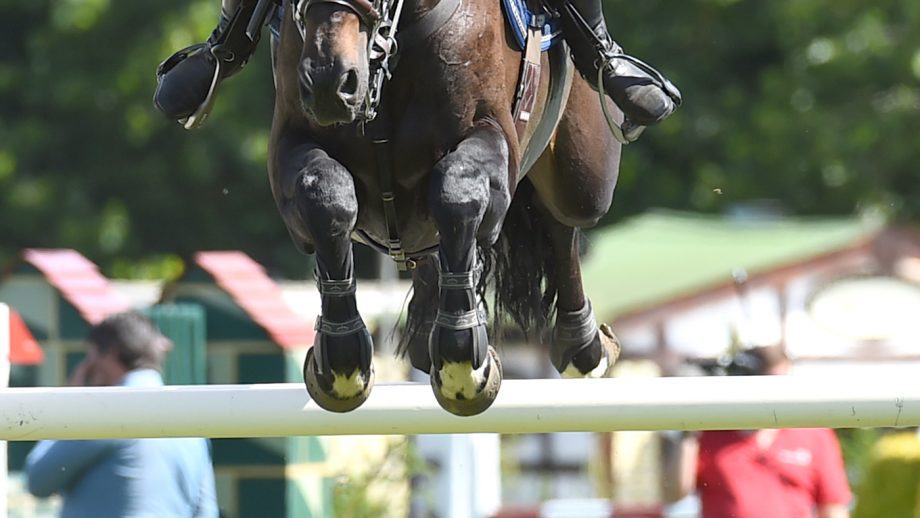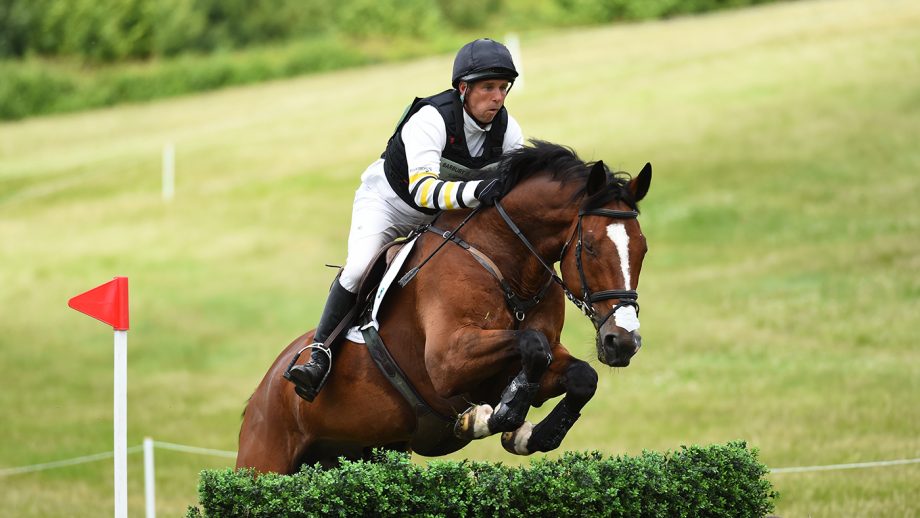As Royal Ascot gets underway, H&H looks back at the first two weeks of racing behind closed doors and speaks to those involved to find out how it has gone...
A fortnight on from its return in Britain, racing has settled into a new rhythm as the rest of the equestrian world takes its initial steps to restarting sport behind closed doors.
Flat racing was among the first sports to resume in Britain, on 1 June, with an all-weather fixture at Newcastle.
Temperature checks, masks, set spots in the paddock and a redesign of the changing rooms have become the new normal over the past two weeks as the eyes of the world – and those looking to restart other sports and equestrian disciplines – watched to see how it would work.
{"content":"PHA+QW5kIGl0IGhhcyB3b3JrZWQg4oCTIGFzIDxlbT5IJmFtcDtIPC9lbT4gbWFnYXppbmUgd2VudCB0byBwcmVzcyBhaGVhZCBvZiBSb3lhbCBBc2NvdCAoMTYtMjAgSnVuZSksIHRoZSBvcGVuaW5nIHR3byB3ZWVrcyBoYXZlIHJ1biBzbW9vdGhseSwgd2l0aCBvbmUgcnVubmVyIHNvIGZhciB0dXJuZWQgYXdheSBvd2luZyB0byBhbiBpbmRpdmlkdWFsIHJlY29yZGluZyBhIGhpZ2ggdGVtcGVyYXR1cmUgYXQgYW4gYXJyaXZhbCBjaGVjay48L3A+CjxwPkEgQnJpdGlzaCBIb3JzZXJhY2luZyBBdXRob3JpdHkgKEJIQSkgc3Bva2VzbWFuIHRvbGQgPGVtPkgmYW1wO0g8L2VtPsKg4oCcYSBsb3Qgb2YgaGFyZCB3b3Jr4oCdwqBoYXMgZ29uZSBpbnRvIGdldHRpbmcgdGhlIHJlc3RhcnQgdG\/CoOKAnHJ1biBhcyBzbW9vdGhseSBhcyBpdCBoYXPigJ0uPC9wPgo8cD48ZGl2IGNsYXNzPSJhZC1jb250YWluZXIgYWQtY29udGFpbmVyLS1tb2JpbGUiPjxkaXYgaWQ9InBvc3QtaW5saW5lLTIiIGNsYXNzPSJpcGMtYWR2ZXJ0Ij48L2Rpdj48L2Rpdj48c2VjdGlvbiBpZD0iZW1iZWRfY29kZS0zMSIgY2xhc3M9ImhpZGRlbi1tZCBoaWRkZW4tbGcgcy1jb250YWluZXIgc3RpY2t5LWFuY2hvciBoaWRlLXdpZGdldC10aXRsZSB3aWRnZXRfZW1iZWRfY29kZSBwcmVtaXVtX2lubGluZV8yIj48c2VjdGlvbiBjbGFzcz0icy1jb250YWluZXIgbGlzdGluZy0tc2luZ2xlIGxpc3RpbmctLXNpbmdsZS1zaGFyZXRocm91Z2ggaW1hZ2UtYXNwZWN0LWxhbmRzY2FwZSBkZWZhdWx0IHNoYXJldGhyb3VnaC1hZCBzaGFyZXRocm91Z2gtYWQtaGlkZGVuIj4NCiAgPGRpdiBjbGFzcz0icy1jb250YWluZXJfX2lubmVyIj4NCiAgICA8dWw+DQogICAgICA8bGkgaWQ9Im5hdGl2ZS1jb250ZW50LW1vYmlsZSIgY2xhc3M9Imxpc3RpbmctaXRlbSI+DQogICAgICA8L2xpPg0KICAgIDwvdWw+DQogIDwvZGl2Pg0KPC9zZWN0aW9uPjwvc2VjdGlvbj48L3A+CjxwPuKAnFRoZSB0ZWFtcyBhdCB0aGUgQkhBIGFuZCByYWNlY291cnNlcyBhcyB3ZWxsIGFzIG91ciB0cmFpbmVycywgam9ja2V5cyBhbmQgc3RhYmxlIHN0YWZmIGRlc2VydmUgYSBncmVhdCBkZWFsIG9mIGNyZWRpdCzigJ0gaGUgc2FpZC4g4oCcUHJvdG9jb2xzIGFuZCBndWlkZWxpbmVzIGFyZSBiZWluZyBmb2xsb3dlZCBhbmQgc29jaWFsIGRpc3RhbmNpbmcgcmVzcGVjdGVkLjwvcD4KPHA+4oCcVGhlcmUgaGF2ZSBiZWVuIHNvbWUgdGVjaG5pY2FsIGlzc3Vlcywgd2hpY2ggY291bGQgYmUgZXhwZWN0ZWQgY29uc2lkZXJpbmcgdGhlIHNjYWxlIG9mIHRoZSB0YXNrLCBidXQgZm9ydHVuYXRlbHkgbm90aGluZyB0aGF0IGhhcyBkZXZlbG9wZWQgaW50byBhIG1ham9yIGlzc3VlLuKAnTwvcD4KPHA+SGUgYWRkZWQgdGhlIGFkbWluaXN0cmF0aXZlIHRhc2sgb2YgY2xlYXJpbmcgdGhvc2Ugd2hvIG5lZWQgdG8gYmUgcHJlc2VudCBvbiByYWNlIGRheXMg4oCTIHdoaWNoIHJlcXVpcmVzIGluZGl2aWR1YWxzIHRvIGNvbXBsZXRlIG9ubGluZSBtb2R1bGUgYW5kIHF1ZXN0aW9ubmFpcmUgYmVmb3JlaGFuZCwgYXMgd2VsbCBhcyBvbi1hcnJpdmFsIHNjcmVlbmluZyBjaGVja3Mg4oCTIOKAnGhhcyBiZWVuIGEgY29uc2lkZXJhYmxlIG9uZeKAnSwgd2hpY2ggaGFzIGJlZW4gaGVscGVkIGJ5IG1vdmluZyBmcm9tIDQ4LWhvdXIgdG8gNzItaG91ciBkZWNsYXJhdGlvbnMuPC9wPgo8ZGl2IGNsYXNzPSJhZC1jb250YWluZXIgYWQtY29udGFpbmVyLS1tb2JpbGUiPjxkaXYgaWQ9InBvc3QtaW5saW5lLTMiIGNsYXNzPSJpcGMtYWR2ZXJ0Ij48L2Rpdj48L2Rpdj4KPHA+4oCcV2XigJlyZSBzdGlsbCB3b3JraW5nIHdpdGggdHJhaW5lcnMgdG8gbWFrZSB0aGF0IHByb2Nlc3MgYXMgZWZmaWNpZW50IGFzIHBvc3NpYmxlIGJlZm9yZSB3ZSBtYWtlIHRoZSBtb3ZlIGJhY2sgdG8gNDgtaG91ciBkZWNsYXJhdGlvbnMs4oCdIGhlIGFkZGVkLiDigJxJdCBpcyBzdGlsbCByZWxhdGl2ZWx5IGVhcmx5IGRheXPCoGFuZCB3ZeKAmWxsIGtlZXAgYWxsIG91ciBwcm90b2NvbHMgdW5kZXIgY29uc3RhbnQgcmV2aWV3LuKAnTwvcD4KPGgzPktlZXBpbmcgaW4gdG91Y2g8L2gzPgo8cD5Hb29kIGNvbW11bmljYXRpb24gZnJvbSByYWNpbmfigJlzIG9yZ2FuaXNlcnMgaGFzIGJlZW4ga2V5LCBqb2NrZXlzIGhhdmUgdG9sZCA8ZW0+SCZhbXA7SDwvZW0+LCBhcyBpcyBlbWJyYWNpbmcgdGVjaG5vbG9neSB0byBicmluZyB0aGUgYWN0aW9uIHRvIHRob3NlIHdobyBjYW5ub3QgeWV0IGJlIHRoZXJlLjwvcD4KPGRpdiBjbGFzcz0iYWQtY29udGFpbmVyIGFkLWNvbnRhaW5lci0tbW9iaWxlIj48ZGl2IGlkPSJwb3N0LWlubGluZS00IiBjbGFzcz0iaXBjLWFkdmVydCI+PC9kaXY+PC9kaXY+CjxwPuKAnEl04oCZcyBvYnZpb3VzbHkgZ3JlYXQgdG8gYmUgYmFjayzigJ3CoGxlYWRpbmcgam9ja2V5IE1lZ2FuIE5pY2hvbGxzIHRvbGQgPGVtPkgmYW1wO0g8L2VtPiwgYWRkaW5nIHRoYXQgdHdvIHdlZWtzIG9uLCBldmVyeW9uZSBoYXMgc2V0dGxlZCBpbnRvIHRoZSBuZXcgcmVndWxhdGlvbnMuPC9wPgo8cD7igJxUaGVyZeKAmXMgbm8gY3Jvd2RzIGFuZCBpdOKAmXMgYWxsIHF1aXRlIGRpZmZlcmVudCB0byB3aGF0IHdlIGFyZSB1c2VkIHRvLCBidXQgdGhlIHJhY2luZyByZWd1bGF0b3JzIGdhdmUgdXMgYWxsIHRoZSBpbmZvcm1hdGlvbiBhcyB0byBob3cgaXQgd2FzIGdvaW5nIHRvIHJ1biBhcyBlYXJseSBhcyBwb3NzaWJsZS48L3A+CjxkaXYgY2xhc3M9ImFkLWNvbnRhaW5lciBhZC1jb250YWluZXItLW1vYmlsZSI+PGRpdiBpZD0icG9zdC1pbmxpbmUtNSIgY2xhc3M9ImlwYy1hZHZlcnQiPjwvZGl2PjwvZGl2Pgo8cD7igJxSaWRpbmcgaW4gYSBtYXNrIGhhcyB0YWtlbiBzb21lIGdldHRpbmcgdXNlZCB0byBhbmQgaXQgYWxzbyBkZXBlbmRzIG9uIHRoZSB3ZWF0aGVyIOKAkyBpZiBpdCBpcyBob3Qgb3IgcmFpbmluZyBbdGhhdCBhZmZlY3RzIHdoYXQgaXQgaXMgbGlrZSB0byByYWNlIHdlYXJpbmcgb25lXS4gSWYgd2VhcmluZyBvbmUgbWVhbnMgcmFjaW5nIGNhbiBnbyBhaGVhZCwgSeKAmW0gYWxsIGZvciBpdC7igJ08L3A+CjxwPkpvY2tleSBHZW9yZ2UgV29vZCwgd2hvIGhhcyBtb3JlIHRoYW4gMTUwIHdpbm5lcnMgc2luY2UgaGlzIGRlYnV0IGluIDIwMTYsIGFncmVlZCB0aGF0IOKAnGV2ZXJ5b25lIGlzIGdsYWQgdG8gYmUgYmFja+KAnWFuZCB3aGlsZSB0aGUgZmlyc3QgZmV3IGRheXMgZmVsdCDigJxhIGJpdCBzdHJhbmdl4oCdLCBpdCBoYXMgcXVpY2tseSBzZXR0bGVkIGludG8gZmVlbGluZyBub3JtYWwuPC9wPgo8cD7igJxJdOKAmXMgYmVlbiB2ZXJ5IHdlbGwgcnVuIGFuZCBjcmVkaXQgdG8gdGhlIEJIQSwgY2xlcmtzIG9mIHRoZSBjb3Vyc2VzIGFuZCBldmVyeW9uZSBpbnZvbHZlZCBpbiBnZXR0aW5nIGl0IGdvaW5nIGFnYWluLOKAncKgaGUgdG9sZCA8ZW0+SCZhbXA7SDwvZW0+LCBleHBsYWluaW5nIGhvdyBhbGwgdGhlIGxvZ2lzdGljIGRldGFpbHMgaGF2ZSBiZWVuIHRob3VnaHQgb2YuPC9wPgo8cD7igJxZb3UgbmV2ZXIgaGF2ZSB0byBjb21lIFt3aXRoaW4gdHdvIG1ldHJlc10gb2YgYW55b25lLiBUaGVyZeKAmXMgb25lLXdheSBzeXN0ZW1zIGFyb3VuZCB0aGUgY291cnNlcywgY2hhbmdlcyB0byB0aGUgd2VpZ2hpbmcgcm9vbXMsIHdlIGhhdmUgc2VwYXJhdGUgY3ViaWNsZXMgYW5kIHRoZSB3YXkgZXZlcnlvbmUgaGFzIGNvbmR1Y3RlZCB0aGVtc2VsdmVzIGlzIHZlcnkgcHJvZmVzc2lvbmFsLCBmcm9tIHdlYXJpbmcgbWFza3MgdG8gZmlsbGluZyBvdXQgdGhlIG9ubGluZSBmb3JtcyBhbmQgdGhlIHNhZmV0eSBhbmQgdGVtcGVyYXR1cmUgY2hlY2tzLiBJdCBmZWVscyBhcyBzYWZlIGFzIGl0IGNhbi7igJ08L3A+CjxwPkdlb3JnZSBnYXZlIHRoZSBleGFtcGxlIG9mIHN0YXJ0aW5nIHN0YWxscyBhcyBhIHBsYWNlIHdoZXJlIHNtYWxsIGFkanVzdG1lbnRzIGNhbiBtYWtlIGEgZGlmZmVyZW5jZS48L3A+CjxwPuKAnFdlIGFsbCBoYXZlIG91ciBtYXNrcyB1cCBhbmQgc3RheSBmYWNpbmcgZm9yd2FyZHMsIGJ1dCBub3cgdGhlIHN0YWxsIGhhbmRsZXJzIHNob3V0IGhvdyBtYW55IHRoZXkgaGF2ZSBsZWZ0IHRvIGxvYWQgc28gd2UgZG9u4oCZdCBuZWVkIHRvIHR1cm4gcm91bmQgdG8gbG9vayzigJ3CoGhlIHNhaWQuwqDigJxMaXR0bGUgdGhpbmdzIGxpa2UgdGhhdCBtYWtlIGEgbWFzc2l2ZSBkaWZmZXJlbmNlLuKAnTwvcD4KPHA+Sm9ja2V5IERhbmllbCBNdXNjdXR0LCB3aG8gaGFzIHJpZGRlbiAxNjAtcGx1cyB3aW5uZXJzIGluIEJyaXRhaW4gYW5kIGFicm9hZCwgYWRkZWQgaXQgaXMgYSDigJxiaWcgcmVsaWVm4oCdIHRvIGJlIGJhY2sgYW5kIHRoZSBCSEEgYW5kIFByb2Zlc3Npb25hbCBKb2NrZXlzIEFzc29jaWF0aW9uIGhhdmUgYmVlbiBncmVhdCBpbiBrZWVwaW5nIHRoZW0gdXAgdG8gZGF0ZSB3aXRoIGxhdGVzdCBkZXZlbG9wbWVudHMuPC9wPgo8cD7igJxJdOKAmXMgcnVuIHZlcnkgc21vb3RobHkgYW5kIHRoZSByYWNlY291cnNlcyBhbmQgY2xlcmtzIG9mIHRoZSBjb3Vyc2VzIGhhdmUgZG9uZSBhIGdyZWF0IGpvYiBpbiBhZGFwdGluZyB0aGUgd2F5IHRoaW5ncyBydW4gYXMgYmVzdCB0aGV5IGNhbiBhbmQgZ2V0dGluZyB0aGUgcmlnaHQgcHJvdG9jb2xzIGluIHBsYWNlLOKAncKgaGUgc2FpZC7CoOKAnEl0IGp1c3Qgc2hvd3MgdGhlIHJlc2lsaWVuY2Ugb2YgZXZlcnlvbmUgaW4gdGhlIGluZHVzdHJ5IHdoZW4gaXQgd29ya3MgdG9nZXRoZXIgYW5kIGhvdyB0aGV5IGNhbiBwdWxsIHNvbWV0aGluZyBsaWtlIHRoaXMgb2ZmLuKAnTwvcD4KPHA+SGUgYWRkZWQgb3duZXJzIGRlc2VydmUgbXVjaCByZWNvZ25pdGlvbiBmb3Iga2VlcGluZyB0aGVpciBob3JzZXMgaW4gdHJhaW5pbmcgdGhyb3VnaCBsb2NrZG93biBhbmQgYXQgYSB0aW1lIHdoZW4gdGhleSBjYW7igJl0IHlldCB3YXRjaCB0aGVtIGluIHBlcnNvbiBvbiB0aGUgdHJhY2ssIGFuZCB0aGF0IGtlZXBpbmcgdGhlbSBpbmZvcm1lZCB0aHJvdWdoIHZpZGVvLCBjYWxscyBhbmQgdm9pY2Utbm90ZXMgYmVmb3JlIGFuZCBhZnRlciByYWNlcyBoYXMgYmVjb21lIG1vcmUgaW1wb3J0YW50IHRoYW4gZXZlci48L3A+CjxkaXYgY2xhc3M9ImluamVjdGlvbiI+PC9kaXY+CjxwPuKAnEl04oCZcyBqdXN0IGFib3V0IGdvaW5nIHRoYXQgZXh0cmEgbWlsZSzigJ3CoGhlIHNhaWQuwqDigJxJIGdvdCB1c2VkIHRvIGl0IGEgbG90IHdoZW4gSSB3YXMgcmlkaW5nIGluIEF1c3RyYWxpYSBhbmQgSSB0aGluayBpdOKAmXMgc29tZXRoaW5nIHRoYXQgbWlnaHQgc3RpY2sgYXJvdW5kIHdoZW4gdGhpbmdzIGFyZSBiYWNrIHRvIG5vcm1hbC4gSXTigJlzIGEgZ29vZCB3YXkgdG8gc2hhcmUgaW5mb3JtYXRpb24sIGVzcGVjaWFsbHkgZm9yIHN5bmRpY2F0ZSBob3JzZXMgd2hlcmUgdGhlcmUgYXJlIHF1aXRlIGEgZmV3IG1lbWJlcnMu4oCdPC9wPgo8cD4K"}
You may also be interested in…
Stay in touch with all the news in the run-up to and throughout the major shows and events during 2025 and beyond with a Horse & Hound subscription. Subscribe today for all you need to know ahead of these major events, plus online reports on the action as it happens from our expert team of reporters and in-depth analysis in our special commemorative magazines. Have a subscription already? Set up your unlimited website access now
H&H senior news writer
Lucy is an experienced news journalist, reporter and presenter. Since joining the Horse & Hound team in 2015, Lucy has reported from major global sporting events including the Tokyo Paralympic Games and multiple European Championships, as well as Badminton, Burghley and London, to name a few. She has covered current affairs and sports news across the full spectrum of equestrian disciplines and racing, as well as human and equine welfare, industry news and court cases.






